View in other NatureServe Network Field Guides
NatureServe
Montana
Utah
Wyoming
Idaho
Wisconsin
British Columbia
South Carolina
Yukon
California
New York
Black-footed Ferret - Mustela nigripes
General Description
Black-footed Ferrets are weasel-like in body shape and form but are heavier than other weasels. The torso is long with short legs and a long tail. The color of the body is a soft cream color with the ears, chin and throat fading to white. The dorsal portion of the torso is darker than the rest of the body. The legs and tip of the tail are dark brown and a mask of the same color extends in a band from below each eye across the forehead.
Diagnostic Characteristics
Although similar in size and shape to the American Mink (Mustela vison), the much lighter body color and prairie habitat of the Black-footed Ferret are distinctive. Long-tailed Weasels (Mustela frenata) are smaller and less robust and do not have the distinctive black mask and feet of the ferret.
Species Range
Montana Range
Range Descriptions
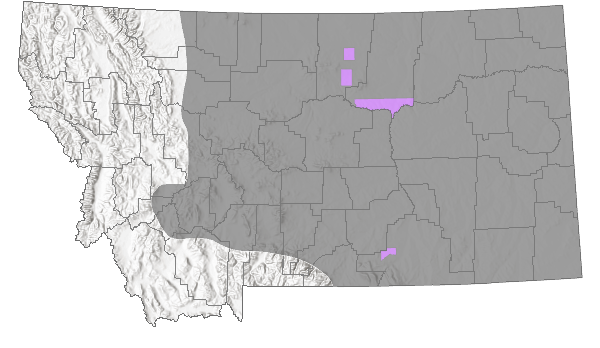 Western Hemisphere Range
Western Hemisphere Range
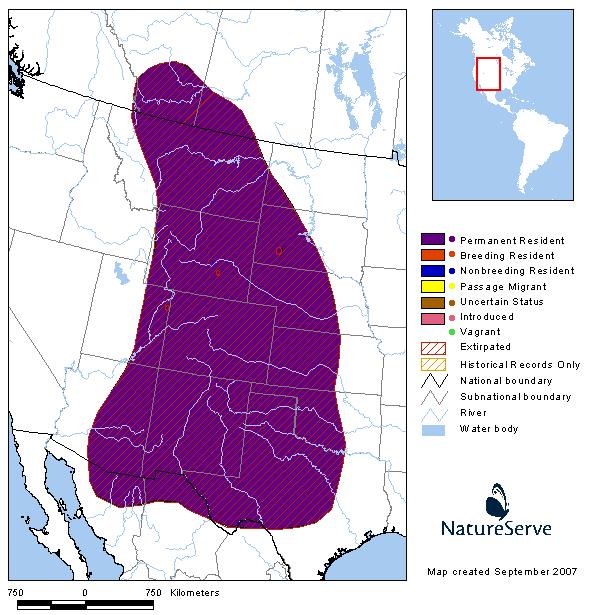
Observations in Montana Natural Heritage Program Database
Number of Observations: 65
(Click on the following maps and charts to see full sized version)
Map Help and Descriptions
Relative Density
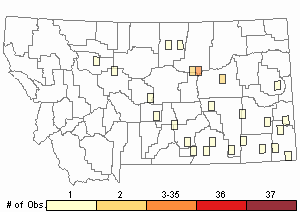
Recency

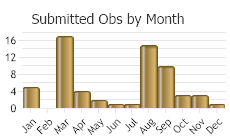
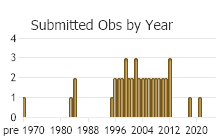
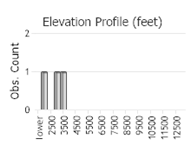 (Observations spanning multiple months or years are excluded from time charts)
(Observations spanning multiple months or years are excluded from time charts)
Migration
Black-footed Ferrets are not known to migrate. Juveniles disperse in September. Adults use about a 100-acre range semi-nomadically (Richardson 1986).
Habitat
Black-footed Ferrets are intimately tied to prairie dogs (Cynomys spp.) throughout their range and have only been found in association with prairie dogs. They are therefore limited to the same open habitat used by prairie dogs: grasslands, steppe, and shrub steppe. Black-footed Ferrets do not dig their own burrows and rely on abandoned prairie dog burrows for shelter. Only large complexes (several thousand acres of closely spaced colonies) can support and sustain a breeding population of Black-footed Ferrets. It has been estimated that about 40 to 60 hectares of prairie dog colony is needed to support one Black-footed Ferret, and females with litters have never been found on colonies less than 49 hectares (Miller et al. 1996). Black-footed Ferrets scent-mark to maintain spatial separation (Richardson 1986).
Ecological Systems Associated with this Species
- Details on Creation and Suggested Uses and Limitations
How Associations Were Made
We associated the use and habitat quality (common or occasional) of each of the 82 ecological systems mapped in Montana for
vertebrate animal species that regularly breed, overwinter, or migrate through the state by:
- Using personal observations and reviewing literature that summarize the breeding, overwintering, or migratory habitat requirements of each species (Dobkin 1992, Hart et al. 1998, Hutto and Young 1999, Maxell 2000, Foresman 2012, Adams 2003, and Werner et al. 2004);
- Evaluating structural characteristics and distribution of each ecological system relative to the species' range and habitat requirements;
- Examining the observation records for each species in the state-wide point observation database associated with each ecological system;
- Calculating the percentage of observations associated with each ecological system relative to the percent of Montana covered by each ecological system to get a measure of "observations versus availability of habitat".
Species that breed in Montana were only evaluated for breeding habitat use, species that only overwinter in Montana were only evaluated for overwintering habitat use, and species that only migrate through Montana were only evaluated for migratory habitat use.
In general, species were listed as associated with an ecological system if structural characteristics of used habitat documented in the literature were present in the ecological system or large numbers of point observations were associated with the ecological system.
However, species were not listed as associated with an ecological system if there was no support in the literature for use of structural characteristics in an ecological system,
even if point observations were associated with that system.
Common versus occasional association with an ecological system was assigned based on the degree to which the structural characteristics of an ecological system matched the preferred structural habitat characteristics for each species as represented in scientific literature.
The percentage of observations associated with each ecological system relative to the percent of Montana covered by each ecological system was also used to guide assignment of common versus occasional association.
If you have any questions or comments on species associations with ecological systems, please contact the Montana Natural Heritage Program's Senior Zoologist.
Suggested Uses and Limitations
Species associations with ecological systems should be used to generate potential lists of species that may occupy broader landscapes for the purposes of landscape-level planning.
These potential lists of species should not be used in place of documented occurrences of species (this information can be requested at:
mtnhp.org/requests) or systematic surveys for species and evaluations of habitat at a local site level by trained biologists.
Users of this information should be aware that the land cover data used to generate species associations is based on imagery from the late 1990s and early 2000s and was only intended to be used at broader landscape scales.
Land cover mapping accuracy is particularly problematic when the systems occur as small patches or where the land cover types have been altered over the past decade.
Thus, particular caution should be used when using the associations in assessments of smaller areas (e.g., evaluations of public land survey sections).
Finally, although a species may be associated with a particular ecological system within its known geographic range, portions of that ecological system may occur outside of the species' known geographic range.
Literature Cited
- Adams, R.A. 2003. Bats of the Rocky Mountain West; natural history, ecology, and conservation. Boulder, CO: University Press of Colorado. 289 p.
- Dobkin, D. S. 1992. Neotropical migrant land birds in the Northern Rockies and Great Plains. USDA Forest Service, Northern Region. Publication No. R1-93-34. Missoula, MT.
- Foresman, K.R. 2012. Mammals of Montana. Second edition. Mountain Press Publishing, Missoula, Montana. 429 pp.
- Hart, M.M., W.A. Williams, P.C. Thornton, K.P. McLaughlin, C.M. Tobalske, B.A. Maxell, D.P. Hendricks, C.R. Peterson, and R.L. Redmond. 1998. Montana atlas of terrestrial vertebrates. Montana Cooperative Wildlife Research Unit, University of Montana, Missoula, MT. 1302 p.
- Hutto, R.L. and J.S. Young. 1999. Habitat relationships of landbirds in the Northern Region, USDA Forest Service, Rocky Mountain Research Station RMRS-GTR-32. 72 p.
- Maxell, B.A. 2000. Management of Montana's amphibians: a review of factors that may present a risk to population viability and accounts on the identification, distribution, taxonomy, habitat use, natural history, and the status and conservation of individual species. Report to U.S. Forest Service Region 1. Missoula, MT: Wildlife Biology Program, University of Montana. 161 p.
- Werner, J.K., B.A. Maxell, P. Hendricks, and D. Flath. 2004. Amphibians and reptiles of Montana. Missoula, MT: Mountain Press Publishing Company. 262 p.
- Commonly Associated with these Ecological Systems
Grassland Systems
Shrubland, Steppe and Savanna Systems
Sparse and Barren Systems
- Occasionally Associated with these Ecological Systems
Forest and Woodland Systems
Wetland and Riparian Systems
Food Habits
Prairie dogs are an important food source; one study found prairie dog remains in 91% of analyzed Black-footed Ferret scats (Hillman and Clark 1980). Alternate prey such as ground squirrels, rabbits, voles and mice are probably eaten opportunistically.
Ecology
Black-footed Ferrets eat and defecate underground. They sometimes drag prey more than 1000 feet in winter. They travel an average of 1 mile per night. They do not adopt one "den burrow" and are semi-nomadic, traveling from burrow to burrow (Richardson 1986).
Reproductive Characteristics
No specific information on Black-footed Ferret reproductive biology is available for Montana, but in other portions of their range copulation occurred in March and early April. Gestation is 42 and 45 days (Foresman 2012). Wild-born litter sizes in South Dakota averaged 3.5 (range 1 to 5) (Hillman and Clark 1980), and 3.3 at emergence in Wyoming (Forrest et al. 1988). Young are born underground in prairie dog burrows. Young appear above ground usually in July and disperse in fall. At least some females reproduce as yearlings (Forrest et al. 1988).
Management
Black-footed Ferrets have been extirpated from most of their former large range mainly as a result of prairie dog and predator control programs. Canine distemper, in conjunction with captures for captive breeding, resulted in extirpation of the last known wild population near Meeteetse, Wyoming by early 1987. See Miller et al. (1996) for more information on the discovery of the Meeteetse population and subsequent distemper-caused decline and captive breeding decisions that occurred in 1985. All known populations are a result of the reintroduction of captive bred Black-footed Ferrets from animals taken into captivity from this population. Reintroductions have occurred annually in Montana on federal and/or tribal land since 1994 with varying success. Predation by Coyotes and Badgers, and long distance dispersal have been the primary problems with the reintroduction efforts, but plague
(Yersinia pestis) has also apparently resulted in deaths for released animals. Some wild reproduction has occurred but no self-sustaining populations have been established yet.
Additional information on the biology and management of Black-footed Ferret populations can be found on the U.S. Fish and Wildlife Service's
Environmental Conservation Online System Species ProfileReferences
- Literature Cited AboveLegend:
 View Online Publication
View Online Publication Foresman, K.R. 2012. Mammals of Montana. Second edition. Mountain Press Publishing, Missoula, Montana. 429 pp.
Foresman, K.R. 2012. Mammals of Montana. Second edition. Mountain Press Publishing, Missoula, Montana. 429 pp. Forrest, S. C., D. E. Biggins, L. Richardson, T. W. Clark, T. M. Campbell III, K. A. Fagerstone, and E. T. Thorne. 1988. Population attributes for the black-footed ferret (Mustela nigripes) at Meeteetse, Wyoming, 1981-1985. Journal of Mammalogy 69:261-273.
Forrest, S. C., D. E. Biggins, L. Richardson, T. W. Clark, T. M. Campbell III, K. A. Fagerstone, and E. T. Thorne. 1988. Population attributes for the black-footed ferret (Mustela nigripes) at Meeteetse, Wyoming, 1981-1985. Journal of Mammalogy 69:261-273. Hillman, C. N. and T. W. Clark. 1980. Mustela nigripes. American Society of Mammalogists, Lawrence, KS. Mammalian Species Number 126:1-3.
Hillman, C. N. and T. W. Clark. 1980. Mustela nigripes. American Society of Mammalogists, Lawrence, KS. Mammalian Species Number 126:1-3. Miller, B., R.P. Reading, and S. Forrest. 1996. Prairie night: black-footed ferrets and the recovery of endangered species. Smithsonian Institute Press. Washington D.C. 320 pp.
Miller, B., R.P. Reading, and S. Forrest. 1996. Prairie night: black-footed ferrets and the recovery of endangered species. Smithsonian Institute Press. Washington D.C. 320 pp. Richardson, L. 1986. On the track of the last black-footed ferrets. Natural History 95(2):69-77.
Richardson, L. 1986. On the track of the last black-footed ferrets. Natural History 95(2):69-77.
- Additional ReferencesLegend:
 View Online Publication
View Online Publication
Do you know of a citation we're missing? Andersen, K. W., and J. K. Jones, Jr. 1971. Mammals of northwestern South Dakota. Univ. Kan Mus. Nat. Hist. Pub. 19:361-393.
Andersen, K. W., and J. K. Jones, Jr. 1971. Mammals of northwestern South Dakota. Univ. Kan Mus. Nat. Hist. Pub. 19:361-393. Anderson, E., S.C. Forrest, T.W. Clark, and L. Richardson. 1986. Paleobiology, biogeography, and systematics of the black-footed ferret, Mustela nigripes (Audubon and Bachman), 1851. pp. 11-62 In: S.L. Wood (ed). Great Basin Naturalist Memoirs: The Black-footed Ferret. Provo, UT: Brigham Young University. 208 p.
Anderson, E., S.C. Forrest, T.W. Clark, and L. Richardson. 1986. Paleobiology, biogeography, and systematics of the black-footed ferret, Mustela nigripes (Audubon and Bachman), 1851. pp. 11-62 In: S.L. Wood (ed). Great Basin Naturalist Memoirs: The Black-footed Ferret. Provo, UT: Brigham Young University. 208 p. Anderson, N.J. and R.P. Stoneberg. 1996. Disease surveillance of coyotes (Canis latrans) removed from the 1995 black-footed ferret (Mustela nigripes) reintroduction site, UL Bend NWR.
Anderson, N.J. and R.P. Stoneberg. 1996. Disease surveillance of coyotes (Canis latrans) removed from the 1995 black-footed ferret (Mustela nigripes) reintroduction site, UL Bend NWR. Biggins, D. and M.H. Schroeder. 1988. Historical and present status of the black-footed ferret. Pages 93-97 in G. L. Shenbeck and R. Lifkin, eds. Proc. eighth Great Plains wildlife damage control workshop. U.S. For. Serv. Gen. Tech. Rep. RM-154.
Biggins, D. and M.H. Schroeder. 1988. Historical and present status of the black-footed ferret. Pages 93-97 in G. L. Shenbeck and R. Lifkin, eds. Proc. eighth Great Plains wildlife damage control workshop. U.S. For. Serv. Gen. Tech. Rep. RM-154. Biggins, D., Miller, B., L. Hanebury, B. Oakleaf, A. Farmer, R. Crete, and A. Dood. 1992. A system for evaluating black-footed ferret habitat. Ft. Collins, CO: USFWS, National Ecology Research Center. 57 p.
Biggins, D., Miller, B., L. Hanebury, B. Oakleaf, A. Farmer, R. Crete, and A. Dood. 1992. A system for evaluating black-footed ferret habitat. Ft. Collins, CO: USFWS, National Ecology Research Center. 57 p. Black-footed Ferret Connections. History of the black-footed ferret (timeline). Accessed 17 June 2002. https://blackfootedferret.org/history/
Black-footed Ferret Connections. History of the black-footed ferret (timeline). Accessed 17 June 2002. https://blackfootedferret.org/history/ Brigham Young University. 1986. The black-footed ferret. Great Basin Naturalist Memoirs No. 8:1-208.
Brigham Young University. 1986. The black-footed ferret. Great Basin Naturalist Memoirs No. 8:1-208. Buck, C.L. 1939. Pattern correlation of mammalian teeth as a means of identification. M.Sc. Thesis. Bozeman, Montana: Montana State University. 55 p.
Buck, C.L. 1939. Pattern correlation of mammalian teeth as a means of identification. M.Sc. Thesis. Bozeman, Montana: Montana State University. 55 p. Cada, J.,T. Campbell, T. Clark, and D. Flath. 1984. The role of landowner cooperation in black-footed ferret recovery. Pp. 18-23 in A. Dood, comp., Agriculture and Wildlife. Proc. Mont. Chapt., The Wildl. Soc., Butte. 85 pp.
Cada, J.,T. Campbell, T. Clark, and D. Flath. 1984. The role of landowner cooperation in black-footed ferret recovery. Pp. 18-23 in A. Dood, comp., Agriculture and Wildlife. Proc. Mont. Chapt., The Wildl. Soc., Butte. 85 pp. Clark, T.W. 1989. Conservation biology of the Black-footed Ferret (Mustela nigripes). Wildlife Preservation Trust, Special Scientific Report No. 3. 175 p.
Clark, T.W. 1989. Conservation biology of the Black-footed Ferret (Mustela nigripes). Wildlife Preservation Trust, Special Scientific Report No. 3. 175 p. Clark, T.W., J. Grensten, M. Gorges, R. Crete, and J. Gill. 1987. Analysis of black-footed ferret translocation sites in Montana. The Prairie Naturalist 19(1):43-56.
Clark, T.W., J. Grensten, M. Gorges, R. Crete, and J. Gill. 1987. Analysis of black-footed ferret translocation sites in Montana. The Prairie Naturalist 19(1):43-56. COSEWIC 2000. COSEWIC Assessment and Status Report on the Black-Footed Ferret Mustela nigripes in Canada. Committee on the Status of Endangered Wildlife in Canada. Ottawa. VI + 9 Pp.
COSEWIC 2000. COSEWIC Assessment and Status Report on the Black-Footed Ferret Mustela nigripes in Canada. Committee on the Status of Endangered Wildlife in Canada. Ottawa. VI + 9 Pp. COSEWIC. 1978. Saskatchewan Department of Tourism and Renewable Resources. COSEWIC Status Report on the Black-Footed Ferret Mustela nigripes in Canada. Committee on the Status of Endangered Wildlife in Canada. Ottawa. 1-9 Pp.
COSEWIC. 1978. Saskatchewan Department of Tourism and Renewable Resources. COSEWIC Status Report on the Black-Footed Ferret Mustela nigripes in Canada. Committee on the Status of Endangered Wildlife in Canada. Ottawa. 1-9 Pp. Crabb, W.D. and G.W. Watson. 1950. General Notes: Black-footed ferret in Montana. Journal of Mammalogy 31(1):99.
Crabb, W.D. and G.W. Watson. 1950. General Notes: Black-footed ferret in Montana. Journal of Mammalogy 31(1):99. Dood, A.R. 1986. Black-footed ferret (Mustela nigripes) survey and inventory. Job Progress Report. Montana Department of Fish Wildlife and Parks, Proj. No. SE-1 Job No. 3. 10 p.
Dood, A.R. 1986. Black-footed ferret (Mustela nigripes) survey and inventory. Job Progress Report. Montana Department of Fish Wildlife and Parks, Proj. No. SE-1 Job No. 3. 10 p. Federal Register 1996. EPA: Federal Register: Endangered and Threatened Wildlife and Plants Establishment. 20 March 1996.
Federal Register 1996. EPA: Federal Register: Endangered and Threatened Wildlife and Plants Establishment. 20 March 1996. Federal Register, 1 October 1998. Endangered and Threatened Wildlife and Plants: Establishment of a Nonessential Experimental Population of Black-footed Ferrets in Northwestern Colorado and Northeastern Utah.
Federal Register, 1 October 1998. Endangered and Threatened Wildlife and Plants: Establishment of a Nonessential Experimental Population of Black-footed Ferrets in Northwestern Colorado and Northeastern Utah. Federal Register, 11 September 2002. Endangered and Threatened Wildlife and Plants: Proposed Establishment of a Nonessential Experimental Population of Black-footed Ferrets in South-central South Dakota.
Federal Register, 11 September 2002. Endangered and Threatened Wildlife and Plants: Proposed Establishment of a Nonessential Experimental Population of Black-footed Ferrets in South-central South Dakota. Federal Register, 13 October 2000. Endangered and Threatened Wildlife and Plants; Establishment of a Nonessential Experimental Population of Black-footed Ferrets in North-Central South Dakota.
Federal Register, 13 October 2000. Endangered and Threatened Wildlife and Plants; Establishment of a Nonessential Experimental Population of Black-footed Ferrets in North-Central South Dakota. Federal Register, 18 August 1994. Endangered and Threatened Wildlife and Plants: Establishment of a Nonessential Experimental Population of Black-footed Ferrets in North-Central Montana; Final Rule. Federal Register 59(159):42696-42715.
Federal Register, 18 August 1994. Endangered and Threatened Wildlife and Plants: Establishment of a Nonessential Experimental Population of Black-footed Ferrets in North-Central Montana; Final Rule. Federal Register 59(159):42696-42715. Federal Register, 29 April 1997. Endangered and Threatened Wildlife and Plants: Proposed Establishment of a Nonessential Experimental Population of Black-footed Ferrets in Northwestern Colorado and Northeastern Utah.
Federal Register, 29 April 1997. Endangered and Threatened Wildlife and Plants: Proposed Establishment of a Nonessential Experimental Population of Black-footed Ferrets in Northwestern Colorado and Northeastern Utah. Fish and Wildlife Service. 1993. Endangered and threatened wildlife and plants: proposed establishment of a nonessential experimantal population of black-footed ferrets in north-central Montana. Federal Register 58(69):19221-19231.
Fish and Wildlife Service. 1993. Endangered and threatened wildlife and plants: proposed establishment of a nonessential experimantal population of black-footed ferrets in north-central Montana. Federal Register 58(69):19221-19231. Flath, D. L. 1976. The black-footed ferret. Montana Outdoors 7:8-10.
Flath, D. L. 1976. The black-footed ferret. Montana Outdoors 7:8-10. Flath, D. L. and T. W. Clark. 1984. Montana: crucial key to ferret recovery. Defenders. Sep/Oct 1984 59(4):3034.
Flath, D. L. and T. W. Clark. 1984. Montana: crucial key to ferret recovery. Defenders. Sep/Oct 1984 59(4):3034. Flath, D. L., and T. W. Clark. 1989. America's most endangered mammal: the effort to save the black-footed ferret. Bison (Brookfield Zoo) 4: 18-23.
Flath, D. L., and T. W. Clark. 1989. America's most endangered mammal: the effort to save the black-footed ferret. Bison (Brookfield Zoo) 4: 18-23. Flath, D. L.. and T. W. Clark. 1984. Montana: Crucial key to ferret recovery. Montana Outdoors 15(3):34-37.
Flath, D. L.. and T. W. Clark. 1984. Montana: Crucial key to ferret recovery. Montana Outdoors 15(3):34-37. Flath, D.L. 1978. Black-footed ferret inventory and management development plan for southeastern Montana. Montana Fish Wildlife and Parks. 10 pp.
Flath, D.L. 1978. Black-footed ferret inventory and management development plan for southeastern Montana. Montana Fish Wildlife and Parks. 10 pp. Flath, D.L. 1979. Nongame species of special interest or concern: Mammals, birds, reptiles, amphibians, fishes. Wildlife Division, Montana Department of Fish and Game. Helena, MT.
Flath, D.L. 1979. Nongame species of special interest or concern: Mammals, birds, reptiles, amphibians, fishes. Wildlife Division, Montana Department of Fish and Game. Helena, MT. Flath, D.L. and T.W. Clark. 1986. Historic status of black-footed ferret habitat in Montana. pp. 63-71 In: S.L. Wood (ed). Great Basin Naturalist Memoirs: The Black-footed Ferret. Provo, UT: Brigham Young University. 208 pp.
Flath, D.L. and T.W. Clark. 1986. Historic status of black-footed ferret habitat in Montana. pp. 63-71 In: S.L. Wood (ed). Great Basin Naturalist Memoirs: The Black-footed Ferret. Provo, UT: Brigham Young University. 208 pp. Foresman, K.R. 2001. The wild mammals of Montana. American Society of Mammalogists, Special Publication Number 12. Lawrence, KS. 278 pp.
Foresman, K.R. 2001. The wild mammals of Montana. American Society of Mammalogists, Special Publication Number 12. Lawrence, KS. 278 pp. Godbey, J. and D. Biggins. 1994. Recovery of the Black-footed Ferret: Looking Back, Looking Forward. Endangered Species Technical Bulletin 19(1): 10, 13.
Godbey, J. and D. Biggins. 1994. Recovery of the Black-footed Ferret: Looking Back, Looking Forward. Endangered Species Technical Bulletin 19(1): 10, 13. Greenwalt, L. A., 1978, Black-Footed Ferret Recovery Plan
Greenwalt, L. A., 1978, Black-Footed Ferret Recovery Plan Herman, M. and E.E. Willard. 1977. Black-footed ferret and its habitat. U.S. Forest Service, Region 1 and MT Forest and Conservation Experiment Station, UM Forestry School. 12 p.
Herman, M. and E.E. Willard. 1977. Black-footed ferret and its habitat. U.S. Forest Service, Region 1 and MT Forest and Conservation Experiment Station, UM Forestry School. 12 p. Hoffmann, R.S. and D.L. Pattie. 1968. A guide to Montana mammals: identification, habitat, distribution, and abundance. Missoula, MT: University of Montana. 133 p.
Hoffmann, R.S. and D.L. Pattie. 1968. A guide to Montana mammals: identification, habitat, distribution, and abundance. Missoula, MT: University of Montana. 133 p. Hoffmann, R.S., P.L. Wright, and F.E. Newby. 1969. The distribution of some mammals in Montana. I. Mammals other than bats. Journal of Mammalogy 50(3): 579-604.
Hoffmann, R.S., P.L. Wright, and F.E. Newby. 1969. The distribution of some mammals in Montana. I. Mammals other than bats. Journal of Mammalogy 50(3): 579-604. Howard, T. 1985. Distemper takes toll of ferrets. Billings, MT: Billings Gazette. 25 October 1985. pp. 1 and 18A.
Howard, T. 1985. Distemper takes toll of ferrets. Billings, MT: Billings Gazette. 25 October 1985. pp. 1 and 18A. Johnson, C.M. 2002. Effects of black-tailed prairie dogs on the mixed-grass prairie in Montana. M.Sc. Thesis. Bozeman, MT: Montana State University. 89 p.
Johnson, C.M. 2002. Effects of black-tailed prairie dogs on the mixed-grass prairie in Montana. M.Sc. Thesis. Bozeman, MT: Montana State University. 89 p. Jones, J.K., D.M. Armstrong, R.S. Hoffmann and C. Jones. 1983. Mammals of the northern Great Plains. University of Nebraska Press, Lincoln. 379 pp.
Jones, J.K., D.M. Armstrong, R.S. Hoffmann and C. Jones. 1983. Mammals of the northern Great Plains. University of Nebraska Press, Lincoln. 379 pp. Joslin, Gayle, and Heidi B. Youmans. 1999. Effects of recreation on Rocky Mountain wildlife: a review for Montana. [Montana]: Montana Chapter of the Wildlife Society.
Joslin, Gayle, and Heidi B. Youmans. 1999. Effects of recreation on Rocky Mountain wildlife: a review for Montana. [Montana]: Montana Chapter of the Wildlife Society. Kotynski, T. 1977. Montana may have a ferret in its future. Great Falls, MT: Great Falls Tribune. 28 October 1977.
Kotynski, T. 1977. Montana may have a ferret in its future. Great Falls, MT: Great Falls Tribune. 28 October 1977. Lampe, R.P., J.K. Jones Jr., R.S. Hoffmann, and E.C. Birney. 1974. The mammals of Carter County, southeastern Montana. Occa. Pap. Mus. Nat. Hist. Univ. Kan. 25:1-39.
Lampe, R.P., J.K. Jones Jr., R.S. Hoffmann, and E.C. Birney. 1974. The mammals of Carter County, southeastern Montana. Occa. Pap. Mus. Nat. Hist. Univ. Kan. 25:1-39. Linder, R.L. and C.N. Hillman. 1973. Proceedings of the black-footed ferret and prairie dog workshop, September 4-6. Rapid City, SD: South Dakota State University. 208 p.
Linder, R.L. and C.N. Hillman. 1973. Proceedings of the black-footed ferret and prairie dog workshop, September 4-6. Rapid City, SD: South Dakota State University. 208 p. Linder, Rayond L., and Conrad N. Hillman, 1973, Proceedings of the Black-footed Ferret and Prairie Dog Workshop, September 4-6, 1973. Rapid City, South Dakota.
Linder, Rayond L., and Conrad N. Hillman, 1973, Proceedings of the Black-footed Ferret and Prairie Dog Workshop, September 4-6, 1973. Rapid City, South Dakota. Madson, C. 1985. Ferrets need your help. Wyoming Wildlife 49(11):10-13.
Madson, C. 1985. Ferrets need your help. Wyoming Wildlife 49(11):10-13. Maguire, L.A., T.W. Clark, R. Crete, J. Cada, C. Groves, M.L. Shaffer, and U.S. Seal. 1988. Black-footed ferret recovery in Montana: a decision analysis. Wildlife Society Bulletin 16:111-120.
Maguire, L.A., T.W. Clark, R. Crete, J. Cada, C. Groves, M.L. Shaffer, and U.S. Seal. 1988. Black-footed ferret recovery in Montana: a decision analysis. Wildlife Society Bulletin 16:111-120. Marston, B. 1986. Ferret colony edges closer to extinction. High Country News Vol. 18, 20 January 1986.
Marston, B. 1986. Ferret colony edges closer to extinction. High Country News Vol. 18, 20 January 1986. Martin, P. R. 1978. Black-footed ferret inventory and management development plan for southeastern Montana. Montana Dep. Fish and Game, Helena.
Martin, P. R. 1978. Black-footed ferret inventory and management development plan for southeastern Montana. Montana Dep. Fish and Game, Helena. Matchett, M.R., T.R. Stanley, M.F. Mccollister, D.A. Eads, J.T. Boulerice, and D.E. Biggins. 2021. Oral sylvatic plague vaccine does not adequately protect prairie dogs (Cynomys spp.) for endangered black-footed ferret (Mustela nigripes) conservation. Vector-Borne and Zoonotic Diseases 21(12):1-20.
Matchett, M.R., T.R. Stanley, M.F. Mccollister, D.A. Eads, J.T. Boulerice, and D.E. Biggins. 2021. Oral sylvatic plague vaccine does not adequately protect prairie dogs (Cynomys spp.) for endangered black-footed ferret (Mustela nigripes) conservation. Vector-Borne and Zoonotic Diseases 21(12):1-20. Matchett, R. 1999. Black-footed ferret recovery activities on the UL Bend and Charles M. Russell National Wildlife Refuges, Phillips County, Montana. Lewistown, MT: USFWS, 1998 Annual Report and 5-Year Summary. 38 p.
Matchett, R. 1999. Black-footed ferret recovery activities on the UL Bend and Charles M. Russell National Wildlife Refuges, Phillips County, Montana. Lewistown, MT: USFWS, 1998 Annual Report and 5-Year Summary. 38 p. Mead, E.M. and J.I. Mead. 1989. Snake Creek burial cave and a review of the Quaternary mustelids of the Great Basin. Great Basin Naturalist 49(2):143-154.
Mead, E.M. and J.I. Mead. 1989. Snake Creek burial cave and a review of the Quaternary mustelids of the Great Basin. Great Basin Naturalist 49(2):143-154. Miller, B., C. Wemmer, D. Biggins, and R. Reading. 1990. A proposal to conserve black-footed ferrets and the prairie dog ecosystem. Environmental Management 14(6):763-769.
Miller, B., C. Wemmer, D. Biggins, and R. Reading. 1990. A proposal to conserve black-footed ferrets and the prairie dog ecosystem. Environmental Management 14(6):763-769. Miller, B.J., G.E. Menkens, and S.H. Anderson. 1984. A field habitat model for black-footed ferrets [draft]. Paper presented at 8th Great Plains Wildlife Damage Control Workshop at Rapid City, SD: April 28-30. 4 p.
Miller, B.J., G.E. Menkens, and S.H. Anderson. 1984. A field habitat model for black-footed ferrets [draft]. Paper presented at 8th Great Plains Wildlife Damage Control Workshop at Rapid City, SD: April 28-30. 4 p. Mont. Dept. of Agriculture., 1985, Controlling burrowing rodents with burrow fumigants. Inform. Bul. No. 6.
Mont. Dept. of Agriculture., 1985, Controlling burrowing rodents with burrow fumigants. Inform. Bul. No. 6. Mont. Dept. of Agriculture., 1985?, Prairie dog control bulletin.
Mont. Dept. of Agriculture., 1985?, Prairie dog control bulletin. Montana Prairie Dog Working Group. 2002. Conservation plan for black-tailed and white-tailed prairie dogs in Montana. Montana Fish, Wildlife and Parks. Helena MT. 51 pp.
Montana Prairie Dog Working Group. 2002. Conservation plan for black-tailed and white-tailed prairie dogs in Montana. Montana Fish, Wildlife and Parks. Helena MT. 51 pp. MT Department of Fish, Wildlife and Parks. 1992. North central Montana black-footed ferret reintroduction. Helena, MT: Final environmental assessment, in cooperation with U.S. Fish and Wildlife Service. 29 p.
MT Department of Fish, Wildlife and Parks. 1992. North central Montana black-footed ferret reintroduction. Helena, MT: Final environmental assessment, in cooperation with U.S. Fish and Wildlife Service. 29 p. Multiple Authors. 1992. Abstracts from Montana Rare Animal Meeting. Lewistown, MT. November 5-6, 1992. 20 p.
Multiple Authors. 1992. Abstracts from Montana Rare Animal Meeting. Lewistown, MT. November 5-6, 1992. 20 p. N.Y. Times News Service. 1984. Count finds 128 rare ferrets. Helena, MT: Independent Record. 9 September 1984.
N.Y. Times News Service. 1984. Count finds 128 rare ferrets. Helena, MT: Independent Record. 9 September 1984. Oldemeyer, J.L., D.E. Biggins, B.J. Miller, and R. Crete, editors. 1993. Proc. of the symposium on the management of prairie dog complexes for the reintroduction of the black-footed ferret. U.S. Fish Wildl. Serv. Biol. Rep., No. 13. 96 pp.
Oldemeyer, J.L., D.E. Biggins, B.J. Miller, and R. Crete, editors. 1993. Proc. of the symposium on the management of prairie dog complexes for the reintroduction of the black-footed ferret. U.S. Fish Wildl. Serv. Biol. Rep., No. 13. 96 pp. Olinger, J.M. 1988. Rare ferrets spotted in Waterton. Great Falls, MT: Great Falls Tribune. 29 June 1988. pp. 1A-2A.
Olinger, J.M. 1988. Rare ferrets spotted in Waterton. Great Falls, MT: Great Falls Tribune. 29 June 1988. pp. 1A-2A. Owen, P. R., C. J. Bell, and E. M. Mead. 2000. Fossils, diet, and conservation of black-footed ferrets (Mustela nigripes). Journal of Mammalogy 81:422-433.
Owen, P. R., C. J. Bell, and E. M. Mead. 2000. Fossils, diet, and conservation of black-footed ferrets (Mustela nigripes). Journal of Mammalogy 81:422-433. Parker, L. 1985. The Montana black-footed ferret recovery project. Produced by MTFWP, BIA, BLM, Turner Foundation, USFWS, Yellowstone Valley Audubon Society. 8 p.
Parker, L. 1985. The Montana black-footed ferret recovery project. Produced by MTFWP, BIA, BLM, Turner Foundation, USFWS, Yellowstone Valley Audubon Society. 8 p. Plumb, G. E., B. Bessken, and P. Marinari. 1995. Reopening a niche at Badlands National Park: the black-footed ferret. Park Science 15(2):1, 16-18.
Plumb, G. E., B. Bessken, and P. Marinari. 1995. Reopening a niche at Badlands National Park: the black-footed ferret. Park Science 15(2):1, 16-18. Randall, D. 1986. Defenders special report: survival crisis at Meeteetse. Defenders 61(1):4-10.
Randall, D. 1986. Defenders special report: survival crisis at Meeteetse. Defenders 61(1):4-10. Reading, R. P. and T. W. Clark. 1990. Black-footed ferret annotated bibliography, 1986-1990. Montana BLM Wildlife Technical Bulletin No. 3, Billings. 22 pp.
Reading, R. P. and T. W. Clark. 1990. Black-footed ferret annotated bibliography, 1986-1990. Montana BLM Wildlife Technical Bulletin No. 3, Billings. 22 pp. Reading, R.P. and S.R. Kellert. 1993. Attitudes toward a proposed reintroduction of black-footed ferrets (Mustela nigripes). Conservation Biology 7(3):569-580.
Reading, R.P. and S.R. Kellert. 1993. Attitudes toward a proposed reintroduction of black-footed ferrets (Mustela nigripes). Conservation Biology 7(3):569-580. Reid, F. 2006. Peterson Field Guide to Mammals of North America, 4th Edition. Houghton Mifflin Company: Boston and New York, 608 pp.
Reid, F. 2006. Peterson Field Guide to Mammals of North America, 4th Edition. Houghton Mifflin Company: Boston and New York, 608 pp. Rickart, E.A. 1987. Spermophilus townsendii. Mammalian Species 268:1-6.
Rickart, E.A. 1987. Spermophilus townsendii. Mammalian Species 268:1-6. Snow, C. 1972. Habitat management series for endangered species. Report No. 2. Black-footed Ferret (Mustela Nigripes). USDI Bureau of Land Management Tech. Note 168. 23 p.
Snow, C. 1972. Habitat management series for endangered species. Report No. 2. Black-footed Ferret (Mustela Nigripes). USDI Bureau of Land Management Tech. Note 168. 23 p. The Montana Black-footed Ferret Recovery Project. 1999. Ferret facts. Malta, MT: Bowdoin National Wildlife Refuge Vol. 4(1). 7 p.
The Montana Black-footed Ferret Recovery Project. 1999. Ferret facts. Malta, MT: Bowdoin National Wildlife Refuge Vol. 4(1). 7 p. The Montana Black-footed Ferret Recovery Project. 2000. Ferret Facts Vol. 6(1) Malta, MT: Bowdoin National Wildlife Refuge. 4 p.
The Montana Black-footed Ferret Recovery Project. 2000. Ferret Facts Vol. 6(1) Malta, MT: Bowdoin National Wildlife Refuge. 4 p. The Montana Black-footed Ferret Recovery Project.1999. Ferret facts. Malta, MT: Bowdoin National Wildlife Refuge Vol. 4(2). 3 p.
The Montana Black-footed Ferret Recovery Project.1999. Ferret facts. Malta, MT: Bowdoin National Wildlife Refuge Vol. 4(2). 3 p. Thorne, E. T., and E. S. Williams. 1988. Disease and endangered species: the black-footed ferret as a recent example. Conservation Biology 2:66-74.
Thorne, E. T., and E. S. Williams. 1988. Disease and endangered species: the black-footed ferret as a recent example. Conservation Biology 2:66-74. U.S. Fish & Wildlife Service., 1984, Charles M. Russell National Wildlife Refuge, Montana: Draft Environmental Impact Statement.
U.S. Fish & Wildlife Service., 1984, Charles M. Russell National Wildlife Refuge, Montana: Draft Environmental Impact Statement. U.S. Fish & Wildlife Service., 1985, Charles M. Russell National Wildlife Refuge, Montana: Final Environmental Impact Statement.
U.S. Fish & Wildlife Service., 1985, Charles M. Russell National Wildlife Refuge, Montana: Final Environmental Impact Statement. U.S. Fish and Wildlife Service. 1980. Management of Charles M. Russell National Wildlife Refuge. Draft. Reprint
U.S. Fish and Wildlife Service. 1980. Management of Charles M. Russell National Wildlife Refuge. Draft. Reprint Waterton Lakes National Park. Waterton officials unsure if sightings are related species. Great Falls, MT: Great Falls Tribune. 30 June 1988. pp. 1A-2A.
Waterton Lakes National Park. Waterton officials unsure if sightings are related species. Great Falls, MT: Great Falls Tribune. 30 June 1988. pp. 1A-2A. Wildlife Biologist, Fort Belknap Indian Community. 1999. 1999 Black-footed ferret reintroduction activities on Fort Belknap Reservation. Permit Report 23 December 1999. 7 p.
Wildlife Biologist, Fort Belknap Indian Community. 1999. 1999 Black-footed ferret reintroduction activities on Fort Belknap Reservation. Permit Report 23 December 1999. 7 p. Wyoming Fish and Game Department. 1985. Ferret update. The Black-footed Ferret Newsletter (special update). 2 p.
Wyoming Fish and Game Department. 1985. Ferret update. The Black-footed Ferret Newsletter (special update). 2 p. Wyoming Game and Fish Department. 1984. The Black-footed Ferret Newsletter Vol. 1 Spring. 4 p.
Wyoming Game and Fish Department. 1984. The Black-footed Ferret Newsletter Vol. 1 Spring. 4 p. Wyoming Game and Fish Department. 1984. The Black-footed Ferret Newsletter Vol. 1 Winter. 4 p.
Wyoming Game and Fish Department. 1984. The Black-footed Ferret Newsletter Vol. 1 Winter. 4 p. Wyoming Game and Fish Department. 1985. The Black-footed Ferret Newsletter Vol. 2(2) Spring. 4 p.
Wyoming Game and Fish Department. 1985. The Black-footed Ferret Newsletter Vol. 2(2) Spring. 4 p. Wyoming Game and Fish Department. 1985. The Black-footed Ferret Newsletter Vol. 2(3) Summer. 4 p.
Wyoming Game and Fish Department. 1985. The Black-footed Ferret Newsletter Vol. 2(3) Summer. 4 p. Wyoming Game and Fish Department. 1986. The Black-footed Ferret Newsletter Vol. 3(1) Winter. 4 p.
Wyoming Game and Fish Department. 1986. The Black-footed Ferret Newsletter Vol. 3(1) Winter. 4 p. Wyoming Game and Fish Department. 1986. The Black-footed Ferret Newsletter Vol. 3(2) Spring. 4 p.
Wyoming Game and Fish Department. 1986. The Black-footed Ferret Newsletter Vol. 3(2) Spring. 4 p. Wyoming Game and Fish Department. 1986. The Black-footed Ferret Newsletter Vol. 3(3) Summer. 4 p.
Wyoming Game and Fish Department. 1986. The Black-footed Ferret Newsletter Vol. 3(3) Summer. 4 p. Wyoming Game and Fish Department. 1986. The Black-footed Ferret Newsletter Vol. 3(4) Fall. 4 p.
Wyoming Game and Fish Department. 1986. The Black-footed Ferret Newsletter Vol. 3(4) Fall. 4 p. Wyoming Game and Fish Department. 1987. The Black-footed Ferret Newsletter Vol. 4(1) Winter. 4 p.
Wyoming Game and Fish Department. 1987. The Black-footed Ferret Newsletter Vol. 4(1) Winter. 4 p. Wyoming Game and Fish Department. 1987. The Black-footed Ferret Newsletter Vol. 4(2) Spring. 4 p.
Wyoming Game and Fish Department. 1987. The Black-footed Ferret Newsletter Vol. 4(2) Spring. 4 p. Wyoming Game and Fish Department. 1987. The Black-footed Ferret Newsletter Vol. 4(3) Summer. 4 p.
Wyoming Game and Fish Department. 1987. The Black-footed Ferret Newsletter Vol. 4(3) Summer. 4 p. Wyoming Game and Fish Department. 1988. The Black-footed Ferret Newsletter Vol. 5(1) Spring/Summer. 6 p.
Wyoming Game and Fish Department. 1988. The Black-footed Ferret Newsletter Vol. 5(1) Spring/Summer. 6 p. Wyoming Game and Fish Department. 1989. The Black-footed Ferret Newsletter Vol. 6(1) Winter. 6 p.
Wyoming Game and Fish Department. 1989. The Black-footed Ferret Newsletter Vol. 6(1) Winter. 6 p. Wyoming Game and Fish Department. 1989. The Black-footed Ferret Newsletter Vol. 6(2) Summer. 4 p.
Wyoming Game and Fish Department. 1989. The Black-footed Ferret Newsletter Vol. 6(2) Summer. 4 p.
- Web Search Engines for Articles on "Black-footed Ferret"
- Additional Sources of Information Related to "Mammals"





